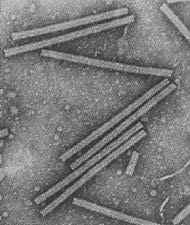

PRIOR diseases or transmissible spongiform encephalopathies (TSEs) are a family of rare progressive neurodegenerative disorders that affect both humans and animals. They are distinguished by long incubation periods, characteristic spongiform changes associated with neuronal loss, and a failure to induce inflammatory response. (causative agent of TSEs )
Viroids are plant pathogens that consist of a short stretch (a few hundred nucleobases) of highly complementary, circular, single-stranded RNA without the protein coat that is typical for viruses.The smallest discovered is a 220 nucleobase scRNA (small cytoplasmic RNA) associated with the rice yellow mottle sobemovirus (RYMV). In comparison, the genome of the smallest known viruses capable of causing an infection by themselves are around 2 kilobases in size. The human pathogen hepatitis D is similar to viroids.Viroids were discovered and given this name by Theodor Otto Diener, a plant pathologist at the Agricultural Research Service in Maryland, in 1971.
#7-Prions, Viroids, and Viruses (virus) are NOT alive because they need a host, and virions crystallize.
Viruses are not living organisms, but efficient parasites that commandeer living cells and turn them into
factories for making more viruses.All living things are composed of one or more cells. Unlike cells, viruses, viroids and prions are acellular agents of infection; nonliving parasites that require a living host to reproduce.


No comments:
Post a Comment